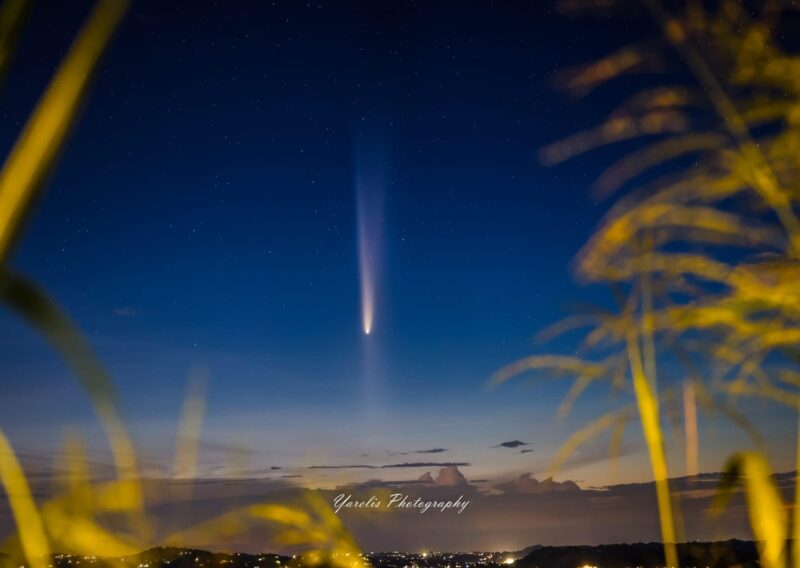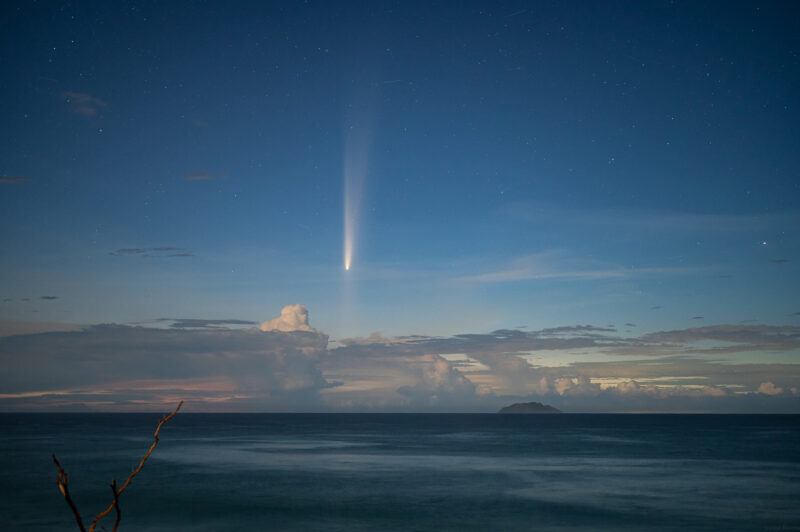
- C/2023 A3 (Tsuchinshan–ATLAS) is currently visible in the evening sky, and it has a rare anti-tail pointing towards the sun.
- An anti-tail is sometimes called an illusion. But it’s real and appears when, as on October 13-15, Earth is crossing the comet’s orbital plane.
- The anti-tail reveals the comet’s past path, or where it has already traveled through space. It’s different from the dust tail, which is created by solar radiation pressure and the solar wind and always points away from the sun.
Comet A3 has an anti-tail!
Comet A3 is becoming easier to spot with the unaided eye, as it moves up and away from the sunset point this week. Try to spot the comet after sunset this week, facing west. The comet was closest to Earth on Saturday, October 12, so this week might be the best time to spot it. Long-exposure (10- to 45-second) images are also showing a faint, downwards or sun directed tail, which is called the anti-tail.
The anti-tail is often said to be an optical illusion, because it appears in the opposite direction of the comet’s dust tail. But it is, in fact, a real phenomenon, visible only when Earth is crossing the comet’s orbital plane.
And we have been passing the comet’s orbital plane since yesterday (October 13), and will keep crossing it on October 14 and 15. Long-exposure images of Comet A3 taken on the last few nights are showing this faint but interesting detail of the comet. It happens because the space geometry – or relative positions of the Earth, the comet and the sun – lets us see sunlight on larger particles left behind by the comet in its orbit. From our perspective, these cometary particles are being lit by the sun from behind.
Meanwhile, the main or brighter tail that we see is caused by the dust and lighter particles being blown away by the intense heat from the sun.

The anti-tail: A possible meteor shower producer?
Although casual observers might be confused and might think the material in the dust tail shows us the comet’s trajectory through space, we should keep in mind that the main dust tail shows its materials (light dust particles and ices sublimated by the sun’s heat) are being blown by the pressure of solar radiation and the solar wind. Hence, a comet’s dust tail always points away from the sun, a fact you can see for yourself as you stand watching this comet in the western sky after sunset.
Meanwhile, the faint downwards anti-tail is showing us where the comet was coming from. Sunlight coming from behind is revealing the comet’s previous trajectory – its orbit – and also shows where the larger particles are being left in the comet’s orbit. These larger particles are the ones that can cause bright meteors if Earth ever were to cross the path of those particles in the future.
A possible meteor shower in the future?
It’s fascinating that this week we can be looking at a possible meteor-producing comet tail. Will we see them? So far, calculations don’t indicate that Earth will cross through those particles’ path. So … no meteors from Comet A3 (that we know of, yet)!
Also, an effect that might be seen this week is a possible slight increase in the comet’s brightness. That’s somewhat surprising, because Earth and the comet have already passed their closest point, so the comet is getting farther away from now. Still, it might look a bit brighter to us now, as Earth crosses the comet’s orbital plane, and as all the dust particles (both light and larger particles) appear more concentrated as seen from Earth.
Bottom line: Comet A3 and Earth have passed their closest point. But, early this week, we’re crossing the plane of the comet’s orbit. Some are seeing an anti-tail!
Read more: Want to see Comet A3? It’s back! West after sunset











